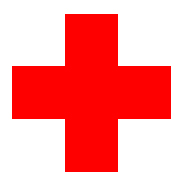

As a new Parent you will want to know what to do in the unlikely but nevertheless possible case you find your baby is not breathing. We asked the health visitor to give us a crash course, and here is the low down. This is for an infant younger than 1 year old. For older children check out out other articles.

It was a few days after our baby was born and every few minutes Clare and myself were craning our necks to look at the baby monitor. A green light flashes every time she moves, we have to constantly apologise to bemused guests who think we are being incredibly rude by turning our backs on them or staring over their shoulders every few minutes.
It was one such time when I had a thought that should have been obvious to me from day one. If the light doesn't flash and I find our baby is not breathing what on earth do I do? I'd call and ambulance and hope the emergency operator would talk me through what to do. For me this wasn't enough, I wanted to be prepared and know exactly what to do.
When the health visitor came the next morning I was itching to ask her. She asked if we had any questions, I was nervous to ask. She probably expected us to ask something like how do we cut her nails, and I came out with 'what if she stops breathing?'. Talk about morbid pessimism, I expected her to be shocked by the question but she didn't miss a beat. She gave us a quick run down and said she would bring a doll and all the information on her next visit.
As promised on her next visit she turned up with all the information and a baby doll to demonstrate on. She told us officially the first thing to do is to check for breathing, heartbeat, and bleeding, and then to call emergency services. I think Clare and I were thinking the same thing. The first thing we would do is call emergency services, the health visitor knew exactly what we were thinking. She said although that is the official advice, you know your baby and just one look will tell you something is wrong. So we would probably make the call immediately while one of us checked for breathing and heart beat.
She said if there was only one of us around it would be a good idea to get help from someone in the immediate vicinity. This way someone could hold the phone and talk to the emergency operator while you deal with your baby. Also you could be doing the rescue breaths while someone else was already calling an ambulance.
With your baby you are looking for signs of not breathing, (blue skin, put your ear near mouth and nose to listen and feel for breathing, and look at chest/tummy for any movement babies breathe more with their belly than chest) and checking the mouth for any obvious obstructions. If you find anything then carefully remove it.
If you are alone and your baby is not breathing then perform chest compression and rescue breaths for one minute before taking your baby with you to call for an ambulance.
I'd been first aider and done a few CPR courses before so was expecting for the next step to be tilting the head back and blowing into the babies mouth. The health visitor says the advice has changed with young babies, tilting the head back can kink the airway so they don't advise you do that for young babies. Put them in the head neutral position which is staring straight ahead, and perhaps tilt the head back an almost imperceptibly small amount from that position.
Also because the baby has such a small face you can put your mouth over both their nose and mouth so no need to pinch the nostrils like you would need to do with an adult.
First of all you need to breathe for them, 5 rescue breaths. Since this is a baby you don't want to be blowing hard or putting too much air in, 5 gentle breaths and allow the chest to deflate after each breath. Next you start chest compression, you want to be pressing in the center of the chest. You press with the tips of two fingers and depress the chest by about a third. Again this is a baby so don't go crazy and press too hard. You give 30 chest compressions then 2 breaths and then keep repeating this cycle.
They say the rate of the chest compressions should be 100 per minute, by my calculations it should take you about 18 seconds to do your 30.
I don't want to confuse anyone, and I suggest you go find out for yourself how to perform these tasks to make sure you get up to date information. I'm just telling you what the health visitor told us. She said although the advise is 5 rescue breaths, then a cycle of 30 chest compressions and 2 breaths, it used to be 15 compression and not 30. It was changed to 30 to help people remember because it's 30 for an adult. So if it were me I'd do 2 breaths and 15 compressions, but as I said go and find out for yourselves if you want to be sure exactly what to do.
In my mind I've got 5 rescue breaths, 15 compressions which should take 9 seconds, then 2 rescue breaths 15 compressions, etc.
We were given the opportunity to have a go on the baby doll she had brought with her. We both declined. I doubt I'll ever need to use the information I've learned but feel much better now I'm prepared to some degree.